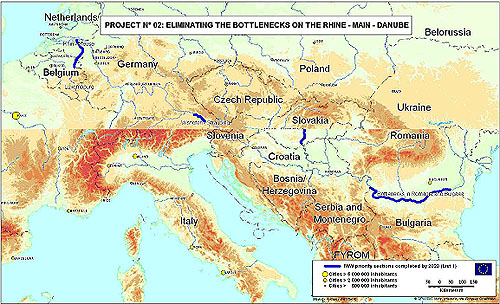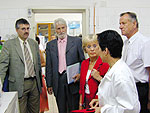The High-Level Group on the Trans-European Transport (TEN-T) Network, chaired
by Karel van Miert, on June 30 this year published a list of priority projects
by 2020.
Within the scope of the TEN network development, the elimination of the bottlenecks
on the Danube between Vienna and Bratislava has been identified as one of the
priority projects for Austria. Improvement of the navigable conditions on the
Danube tops the list of projects expected to be operational by 2020.
 |
Regretting serious under-investment and inadequate Community financial support
which has led to substantial delays in many of the 14 major projects identified
over ten years ago in Essen, the group is recommending to Vice-President Loyola
de Palacio, Vice-President of the European Commission in charge of Transport and
Energy, a change of approach to enable the new priority projects it has selected
to be carried out.
The group's approach, which takes account of the revision of the guidelines for
the trans-European transport network until 2020, is based on coordinating the
investment needed by means of appropriate structures and, as part of the preparation
of the EU's financial perspectives, bringing the Community's financial instruments
into line. This initiative shall fulfill the requirements of adaptation and competitiveness
of the EU through an ambitious policy of infrastructure development as recommended
by President Prodi.
"Given the growing gap between the cost of the infrastructure needed to operate
the major routes of the network and the resources available, the Van Miert Group's
selective approach was essential. Its funding recommendations are an important
contribution to the Commission's thinking on an essential issue that national
budgets and the EU's new financial perspectives cannot ignore", says Loyola
de Palacio.
Wasting public money
NGOs such as T&E, BirdLife International, WWF or Friends of the Earth International
are pleading for a revision of the TEN-T. They are concerned that the key principles
such as cost-benefit analysis, ‘decoupling’ and strategic environmental
assessment have been sidelined in the TEN-T process. The development of the TEN-T
has therefore not been consistent with the principles of sustainable development.
Their key recommendations for improvements to the current TEN-T policy include,
for example, carrying out a full strategic environmental assessment of the whole
network coordinated by the Commission, with the full cooperation of the Member
States to ensure that negative environmental impacts are minimised. Local and
regional transport systems should be maintained and improved before national and
EU funds are allocated to trans-national transport infrastructure. Furthermore,
particular attention should be paid to provisions concerning the prevention of
further deterioration of water quality and the achievement of good ecological
and chemical status for all waters.
A coalition of five environmental groups is now calling for full a strategic environmental
assessment of the completion of the TEN-T. They are „extremly concerned“
about the lack of attention being paid to compatibility of EU transport policies
with the Natura 2000 wildlife network. The clashes between EU transport policy
and EU nature conservation law are highlighted in a new publication by five international
NGOs Transport and Environment, WWF, BirdLife International, Friends of the Earth
Europe, and CEE Bankwatch Network. Conflict Areas between the TEN-T and Nature
Conservation, published by the NGOs as the European Commission prepares proposals
for priority projects in the trans-European transport network (TEN-T), outlines
examples of conflicts between the development of the trans-European transport
network in the candidate countries and Europe’s network of protected wildlife
areas, Natura 2000.
The six cases highlighted in the NGO report involve the Kresna Gorge in Bulgaria,
the D47 road in the Czech Republic, the R35 road in the Czech Republic, highways
No. 2, M3, and No. 47 in Hungary, the Via Baltica in Poland and the Danube-Oder-Elbe
canal in Slovakia, Poland, the Czech Republic, Germany, and Austria. These developments
threaten at least 29 existing or future Natura 2000 sites. All areas at risk host
a high number of plant and animal species of European importance. Two of the six
clashes highlighted by the NGOs are among the priority projects for the trans-European
transport network identified in the Miert-report.
The Miert-report’s primary focus is on infrastructure provision. Yet other
issues are much more important for achieving a well-functioning and sustainable
transport system. These include reducing traffic levels, coordinating the environmental,
social and economic aspects of transport and putting into place an effective pricing
system. The report does mention these crucial issues, but buries them between
the lines of the wordy 75-page document.
"Infrastructure building is tempting, particularly in an economic recession,
when jobs are scarce,” said Beatrice Schell from the European Federation
for Transport and Environment. "But all the evidence tells us that infrastructure
building seldom brings a long-term solution to employment problems.”
A welcome to Ukraine and Serbia and Montenegro
In the last six months, the ICPDR welcomed
two further contracting countries: Ukraine (member as of March 12), and Serbia
and Montenegro (member as of August 9). Even before their official membership,
both countries cooperated under the International Convention for the Protection
of the Danube River. Their official membership will further strengthen international
cooperation within the Danube River Basin.
In the course of the missions to central and downstream Danube Countries, Fritz
Holzwarth, ICPDR President, Joachim Bendow and Philip Weller, the outgoing and
the incoming Executive Secretary respectively will visit both Ukraine and Serbia
and Montenegro in autumn this year to discuss those countries’ specific problems
and concerns in the field of water management. Danube Watch will keep you informed.
Alcoa Foundation donates a TOC/TN Analyser
 |
| From left to right: Juerg Furrer, Director EHS, Alcoa Europe; Joachim Bendow, Executive Secretary, ICPDR; Gisela Raeber, Manager Communications and PR, Alcoa Foundation Europe; Adriana Cociasu, Head of Oceanography, Marine and Coastal Engineering Department, NIMRD; Simion Nicolaev, General Director, NIMRD |
Significant efforts have been made by all Danube
countries to decrease the emission of nutrients and organic pollutants to the
Black Sea and to help restore the Black Sea ecosystems
To control the efficiency of the measures performed, a well-tailored monitoring
system is essential to assess the amount of nitrogen and organic carbon discharged
from the Danube River into the Black Sea. These activities are carried out by
the National Institute for Marine Research and Development (NIMRD) in Constanta,
Romania, and are also linked with the Transnational Monitoring Network of the
ICPDR. Alcoa, the world’s leading producer of primary and fabricated aluminium,
has this year provided substantial support to reinforce the ICPDR monitoring system.
Alcoa Foundation donated a Total Organic Carbon / Total Nitrogen Analyser which
was handed over to NIMRD in Constanta on July 24, 2003. At the ceremony, representatives
of Alcoa praised the Institute’s professionalism. They were convinced that
the donated scientific equipment was put in the right hands and that it would
together with the expertise of Romanian researchers help to reinforce the monitoring
capacities of the ICPDR.
Igor Liska, ICPDR